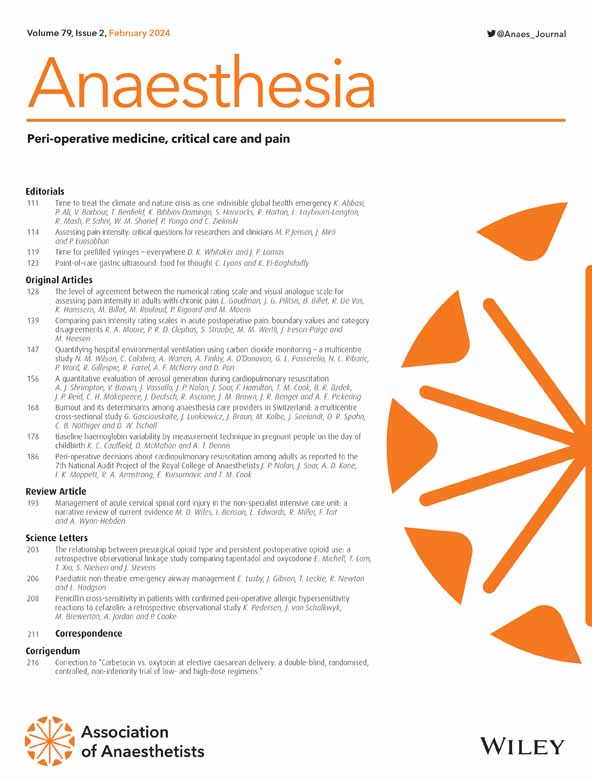静脉美沙酮治疗心脏手术疼痛:一项随机对照试验与血浆浓度分析*
IF 6.9
1区 医学
Q1 ANESTHESIOLOGY
引用次数: 0
摘要
尽管使用了阿片类药物,心脏手术后的疼痛仍然很明显。美沙酮可以改善疼痛控制,减少术后阿片类药物的需要。然而,随机对照试验有限,体外循环对美沙酮药代动力学的影响尚不清楚。本研究的目的是比较心脏手术中的美沙酮和吗啡,测量美沙酮浓度并将其与疼痛控制联系起来。方法接受心脏手术且需要体外循环的患者随机分配给0.2 mg.kg - 1美沙酮或0.2 mg.kg - 1吗啡(基于实际体重,两种药物最大20mg)。分别于拔管后15 min、8 h、12 h、24 h、48 h、72 h,通过吗啡用量和疼痛评分进行评估。评估阿片类药物相关不良事件。术后取血96 h测定血浆美沙酮浓度。结果共分析80例患者,其中美沙酮组40例,吗啡组40例。与吗啡组相比,美沙酮组患者术后24小时和总吗啡需用量显著减少(24小时中位数(IQR[范围])9 (5-16 [0-40])mg vs 24 (17-43 [4-54]) mg (p < 0.001),总35 (23-52 [5-66])mg vs 11 (7-20 [0-44]) mg (p < 0.001))。分配到美沙酮组的患者在休息时(β‐2.24,标准误差0.49,p < 0.001)和咳嗽时(β‐2.16,标准误差0.50,p < 0.001)疼痛评分较低。两组之间阿片类药物相关不良反应的发生率无差异。体外循环期间血浆美沙酮浓度下降,但在给药后约24小时内仍高于最低有效镇痛浓度(平均(SD) 51 (24.7) ng)。Ml‐1基线至30 (10.7)ng。24 h时Ml‐1)。术中美沙酮可减少术后镇痛需求,而不会增加阿片类药物相关不良事件的发生率。本文章由计算机程序翻译,如有差异,请以英文原文为准。
Intravenous methadone for pain management in cardiac surgery: a randomised controlled trial with plasma concentration analysis*
SummaryIntroductionPostoperative pain after cardiac surgery remains significant despite the administration of opioids. Methadone may improve pain control and decrease the need for postoperative opioids. Randomised controlled trials, however, are limited and the effects of cardiopulmonary bypass on methadone pharmacokinetics are unclear. The aims of this study were to compare methadone and morphine in cardiac surgery, measuring methadone concentrations and correlating them with pain control.MethodsPatients undergoing cardiac surgery that required cardiopulmonary bypass were allocated randomly to receive either 0.2 mg.kg‐1 methadone or 0.2 mg.kg‐1 morphine (based on actual body weight, maximum 20 mg for both drugs). Postoperative pain was assessed at 15 min and 8 h, 12 h, 24 h, 48 h and 72 h after tracheal extubation, by analysis of morphine consumption and pain scores. Opioid‐related adverse events were evaluated. Postoperative blood samples were collected for 96 h to measure plasma methadone concentrations.ResultsIn total, 80 patients were analysed (40 allocated to the methadone group, 40 allocated to the morphine group). Patients allocated to the methadone group had significantly reduced 24‐h and total postoperative morphine requirements compared to those allocated to the morphine group (median (IQR [range]) 9 (5–16 [0–40]) mg vs. 24 (17–43 [4–54]) mg (p < 0.001) at 24 h and 35 (23–52 [5–66]) mg vs. 11 (7–20 [0–44]) mg (p < 0.001) total). Patients allocated to the methadone group had lower pain scores at rest (β ‐2.24, standard error 0.49, p < 0.001) and on coughing (β ‐2.16, standard error 0.50, p < 0.001). There was no difference in the incidence of opioid‐related adverse effects between the two groups. Plasma methadone concentration decreased during cardiopulmonary bypass but remained above the minimum effective analgesic concentration for approximately 24 h after administration (mean (SD) 51 (24.7) ng.ml‐1 at baseline to 30 (10.7) ng.ml‐1 at 24 h).DiscussionIntra‐operative methadone reduces postoperative analgesia requirements without increasing the incidence of opioid‐related adverse events.
求助全文
通过发布文献求助,成功后即可免费获取论文全文。
去求助
来源期刊

Anaesthesia
医学-麻醉学
CiteScore
21.20
自引率
9.30%
发文量
300
审稿时长
6 months
期刊介绍:
The official journal of the Association of Anaesthetists is Anaesthesia. It is a comprehensive international publication that covers a wide range of topics. The journal focuses on general and regional anaesthesia, as well as intensive care and pain therapy. It includes original articles that have undergone peer review, covering all aspects of these fields, including research on equipment.
 求助内容:
求助内容: 应助结果提醒方式:
应助结果提醒方式:


